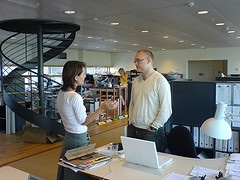 Have you ever had a co-worker with whom you just couldn’t seem to see eye to eye? Perhaps you had drastically different backgrounds or personalities or work styles, but for whatever reason, you clashed, and you dreaded working with that person.
Have you ever had a co-worker with whom you just couldn’t seem to see eye to eye? Perhaps you had drastically different backgrounds or personalities or work styles, but for whatever reason, you clashed, and you dreaded working with that person.
Interpersonal conflicts can create stress and unhappiness in the workplace. The resulting arguments and gossip can disrupt the team dynamic and interfere with productivity. Luckily, there is a simple, effective way to avoid these problems within your organization: the Discself online personality test. If all employees in your company spend 10 minutes answering the questions in the DISCself behavioral assessment, they will better understand their personal behavior style characteristics, as well as those of their colleagues. A small investment of time and money will result in large benefits for the health of your organization with this employee development tool.
- Understand your own style, strengths and weaknesses.
Before you can examine your relationships with others, you must understand how you tick and why you react certain ways in certain situations. It’s interesting to learn more about your personality style, and these insights will help you see what your needs are and how your behaviors come across to other people. As you determine your strengths and weaknesses, you will be able to adjust your actions to get along easily with a variety of different people.
- Identify other people’s styles for better communication.
The resources in the online personality test will help you identify patterns and other clues to help you read people better and understand how they want to be treated. Once you figure out how others operate and what they need to feel supported and valued, your interactions with them will be much more positive and productive.
- Avoid and resolve conflicts.
Learning more about behavior styles teaches you strategies for practicing adaptability in interpersonal situations. For example, if you discover an employee works best in a collaborative, team-oriented environment, but you prefer a results-driven, analytical approach, you could adapt your own style to be more participatory for her benefit. She, in turn, may recognize your efforts and adjust her own approach to complement your needs. As adaptability increases in the organization, conflicts decrease and colleagues are able to work more harmoniously.
- Improve professional relationships.
As you become more adept at identifying personality and behavior characteristics within your organization, you will be able to build and strengthen a cohesive team. You will learn how to communicate effectively using different styles, how to balance your team based on personal strengths and weaknesses and how to prevent conflicts before they occur.
Learn more about the Discself online personality test and how it can benefit your organization.










